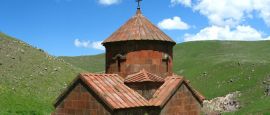Armenia Weather, climate and geography
Weather & climate
Armenia is mostly mountainous (more than 90% of the territory is over 900m/2,286ft above sea level), so expect a dry highland climate.
Springs are short with mild temperatures. Temperatures range from 7°C (45°F) to 19°C (66°F) at the capital Yerevan in April. Rains are scarce, but they do fall in springs.
Summers are dry with plenty of sunshine. In Yerevan, temperatures hover around 33°C (91°F) in August. But in the north, temperatures are cooler and they can fall sharply at night too.
Autumns are long and beautiful, with leaves turning gold and red.
Winters are extremely cold, bleak with heavy snow. Temperatures often dip below 0°C (32°F)
May to June and September to October are good times to visit Yerevan, as the weather is warm but mild. If you are travelling to Lake Sevan, June to September are your best bet.
Geography
Armenia lies on the southern slopes of the Armenian Mountains in the Lesser Caucasus and is bordered by Georgia, Turkey, Azerbaijan and Iran. Its highest peak is Mount Aragats, 4,090m (13,415ft), and even its deepest valleys lie 450 to 700m (1,200 to 1,870ft) above sea level. Its biggest lake is Lake Sevan in the east.
Do you have any Feedback about this page?
© 2025 Columbus Travel Media Ltd. All rights reserved. No part of this site may be reproduced without our written permission, click here for information on Columbus Content Solutions.




 You know where
You know where